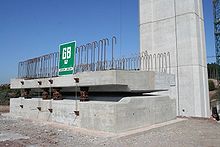Concrete joint
A concrete joint is a swivel joint or a plastic joint made of (steel) concrete , it includes the area of the constriction of a (steel) concrete cross-section, which allows rotation without significant bending stress . This high twistability for concrete cross-sections results on the one hand from the controlled formation of tensile cracks and on the other hand from creep. It is used particularly in bridge construction as a monolithic, simple and inexpensive alternative to an immovable linear tilting bearing . The contact points in the longitudinal joints of segments are also considered to be concrete joints. A concrete joint consists of the constriction area, the so-called joint neck, and the adjacent distribution areas, joint heads.
History and today's regulations
Freyssinet invented concrete joints . Leonhardt formulated design guidelines in the 1960s that are still used today. Janßen introduced its application in tunnel construction. Gladwell developed another design model that makes a more rigid prediction for the deformations than the Leonhardt / Janßen model. Marx and Schacht transferred Leonhardt's regulations for the first time into the semi-propabilistic security concept. For the first time, Schlappal, Kalliauer and co-authors carried out usability and load-bearing capacity verifications . The load-bearing behavior with a mechanically consistent model based on plasticity theory is described for the first time by Kaufmann, Markić and Bimschas.
Tensions, rotatability, load capacity
The load-bearing effect is based on the fact that the strength of the concrete in the joint neck is significantly higher due to three-axis compressive loading than with uniaxial compressive loading, where transverse expansion is possible. The Eurocode 2 allows normal stresses for normal concrete joint dimensions which correspond approximately to double the uniaxial compressive strength. While the joint neck can be unreinforced, the joint heads require appropriate reinforcement due to the splitting tensile forces occurring perpendicular to the normal force .
Well-known bridges
Concrete joints are used in Germany in particular for bridges with a span of up to 15 meters.
Well-known large bridges with concrete joints are among others
- the Hardturm Viaduct in Zurich,
- the Main Valley Bridge Gemünden ,
- the Elbe bridge Mühlberg ,
- the valley bridge Weißenbrunn am Forst
- the Tamina Bridge .
literature
- Fritz Leonhardt: Lectures on solid construction - Part 2 special cases of design in reinforced concrete construction. Springer-Verlag, Berlin 1986, ISBN 3-540-16746-3 , pp. 123-132.
- VPI: The test engineer. April 2010 edition, pp. 15–26, bvpi.de (PDF; 2.3 MB).
Web links
Individual evidence
- ↑ a b c d e f g h i j Johannes Kalliauer, Thomas Schlappal, Markus Vill, Herbert Mang , Bernhard Pichler: Bearing capacity of concrete hinges subjected to eccentric compression: multiscale structural analysis of experiments . In: Acta Mechanica . tape 229 , no. 2 . Springer Nature, February 1, 2018, ISSN 1619-6937 , p. 849–866 , doi : 10.1007 / s00707-017-2004-3 (American English, link.springer.com [PDF] timestamp March 6, 2018).
- ↑ Experiments up to sometimes over 50 mrad were carried out by Schlappal et al. carried out, s. Fig. 11: T. Schlappal, M. Schweigler, S. Gmainer, M. Peyerl, B. Pichler: Creep and cracking of concrete hinges: insight from centric and eccentric compression experiments. In: Materials and structures. Volume 50, number 6, 2017, p. 244, doi : 10.1617 / s11527-017-1112-9 , PMID 29213209 , PMC 5700241 (free full text). .
- ↑ a b Johannes Kalliauer, Thomas Schlappal, Herbert A. Mang, Bernhard Pichler: Parameter identification as the basis for Finite Element simulations of Ultimate Limit States of concrete hinges . In: Günther Meschke, Bernhard Pichler, Jan G. Rots (Eds.): Computational Modeling of Concrete Structures: Proceedings of the Conference on Computational Modeling of Concrete and Concrete Structures (EURO-C 2018), February 26 - March 1, 2018, Bad Hofgastein, Austria . Euro-C2018. CRC Press, 2018, pp. 689 (American English, crcpress.com [accessed March 6, 2018]).
- ↑ a b c d e Thomas Schlappal, Michael Schweigler, Susanne Gmainer, Martin Peyerl, Bernhard Pichler ,: Creep and cracking of concrete hinges: insight from centric and eccentric compression experiments . In: Materials and structures . tape 50 , no. 6 . Springer, 2017, p. 244 , doi : 10.1617 / s11527-017-1112-9 , PMC 5700241 (free full text) - (American English).
- ^ Eugène Freyssinet : Le pont de Candelier (The bridge of Candelier) . In: Ann Ponts Chaussées . tape 1 , 1923, pp. 165 f . (French).
- ^ Eugène Freyssinet : Naissance du béton précontraint et vues d'avenir. In: Travaux, June . 1954, p. 463-474 (French).
- ^ Fritz Leonhardt , Horst Reimann: Concrete joints: test report; Suggestions for dimensioning and constructive training. Critical stress states of the concrete with multi-axial, static short-term loading . Ernst, 1965.
- ↑ Pieter Janßen: Load-bearing behavior of tunnel extensions with articulated segments . Dissertation, Technical University of Braunschweig, 1983.
- ↑ Walter Kaufmann, Tomislav Markić, Martin Bimschas: Concrete joints - state of the art and development potential . Institute for Structural Analysis and Design, ETH Zurich, February 2017 ( ethz.ch [PDF]).
- ↑ Johannes Kalliauer: Insight into the structural behavior of concrete hinges by means of Finite Element simulations . TU Wien - Vienna University of Technology, Vienna April 29, 2016 (American English).



